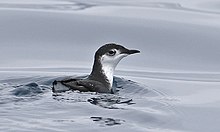| Guadalupe murrelet | |
|---|---|

| |
| Conservation status | |
 Endangered (IUCN 3.1) | |
| Scientific classification | |
| Domain: | Eukaryota |
| Kingdom: | Animalia |
| Phylum: | Chordata |
| Class: | Aves |
| Order: | Charadriiformes |
| Family: | Alcidae |
| Genus: | Synthliboramphus |
| Species: | S. hypoleucus |
| Binomial name | |
| Synthliboramphus hypoleucus (Xántus, J, 1860) | |

| |
The Guadalupe murrelet (Synthliboramphus hypoleucus) or Xantus's murrelet is a small seabird found in the California Current system in the Pacific Ocean. This auk breeds on islands off California and Mexico. It is threatened by predators introduced to its breeding colonies and by oil spills.
This species together with the Scripps's murrelet were considered conspecific and were classified under S. hypoleucus; known collectively as Xantus's murrelet until 2012. Enough evidence was collected to consider both species distinct based on a lack of evidence of interbreeding where the two species nest together on the San Benito Islands, differences in facial pattern and bill shape, vocalizations and genetics.
Description and range
This species is a small black and white auk with a small head and thin sharp bill. It resembles the closely related Scripps's and Craveri's murrelet, with which it shares the distinction of being the most southerly living of all the auk species. It breeds from Guadalupe Island south to the San Benito Islands. After the breeding season it disperses locally at sea northward up to southern California in the United States.
Behavior
Guadalupe murrelet feeds far out at sea, often in association with large pelagic predatory fish like tuna, on larval fish like anchovies, sardines and Sebastes rockfish. Like all auks it is a wing-propelled diver, chasing down prey under the water with powerful wingbeats. There is some speculation that it may feed cooperatively in pairs, as it is almost always observed in pairs, even during the non-breeding season. It flies well, and can take off without taxiing.
It nests in small crevices, caves and under dense bushes on arid islands in loose scattered colonies. It returns to the colony only at night, laying two eggs which are incubated for about a month. Like other synthliboramphine murrelets (e.g. the ancient murrelet) the chicks are highly precocial, leaving the nest within two days of hatching and running actively towards the sea, where the parents call to them. Once at sea the family swims to offshore waters.
Little is known about the time at sea due to difficulties in studying them.
Status and conservation
By the end of the 20th century, the Xantus's murrelet complex was considered to be among the most endangered group of auk. This has changed since, but not because the present species' status has improved, but because other auks have become rarer.
Guadalupe murrelet is mainly threatened by oil spills, as much of its population lives near the busy shipping lanes connecting Los Angeles to other ports. Because a large part of its small population nests in such a small area a single catastrophic oil spill could have far reaching implications. It is also threatened by introduced species such as rats and feral cats; this threat has been lessened lately by efforts to restore its habitat by removing introduced predators.
References
- BirdLife International (2018). "Synthliboramphus hypoleucus". IUCN Red List of Threatened Species. 2018: e.T62101215A132673655. doi:10.2305/IUCN.UK.2018-2.RLTS.T62101215A132673655.en. Retrieved 13 November 2021.
- Jones, Holly P.; Williamhenry, R.; Howald, Gregg R.; Tershy, Bernie R.; Croll, Donald A. (December 2005). "Predation of artificial Xantus's murrelet (Synthliboramphus hypoleucus scrippsi) nests before and after black rat (Rattus rattus) eradication". Environmental Conservation. 32 (4): 320–325. Bibcode:2005EnvCo..32..320J. doi:10.1017/S0376892906002608. ISSN 1469-4387. S2CID 49360219.
- Nettleship, David N.; Kirwan, Guy M. (2020). "Guadalupe Murrelet (Synthliboramphus hypoleucus), version 1.0". Birds of the World. doi:10.2173/bow.xanmur1.01. S2CID 216216779.
- Birt, T. P.; H.R. Carter; D.L. Whitworth; A. McDonald; S.H. Newman; F. Gress; E. Palacios; J.S. Koepke & V.L. Friesen (2012). "Rangewide population genetic structure of Xantus's Murrelet, (S. hypoleucus)". Auk. 129: 44–55. doi:10.1525/auk.2011.11011. S2CID 86799974.
- Jehl, J. R. Jr.; S.I. Bond (1975). "Morphological variation and species limits in murrelets of the genus Endomychura" (PDF). Transactions of the San Diego Society of Natural History. 18: 9–24. doi:10.5962/bhl.part.15542.
- Keitt, B.S. (2005). "Status of Xantus's Murrelet and its nesting habitat in Baja California, Mexico" (PDF). Marine Ornithology. 33: 105–114.
- IUCN Redlist (1988, 1994, 2000)
Further reading
- Drost, C.A. & Lewis, D.B. (1995): Xantus's Murrelet (Synthliboramphus hypoleucus). In: Poole, A. & Gill, F. (eds.): The Birds of North America: 164. Academy of Natural Sciences, Philadelphia, PA & American Ornithologists' Union, Washington, D.C. doi:10.2173/bna.164
- Gaston, Anthony & Jones, Ian (1998): The Auks, Alcidae. Oxford University Press, Oxford. ISBN 0-19-854032-9
- Thayer, John E.; Bangs, Outram (1908). "The Present State of the Ornis of Guadaloupe Island" (PDF). Condor. 10 (3): 101–106. doi:10.2307/1360977. hdl:2027/hvd.32044072250186. JSTOR 1360977.
| Taxon identifiers | |
|---|---|
| Synthliboramphus hypoleucus |
|
| Brachyramphus hypoleucus | |